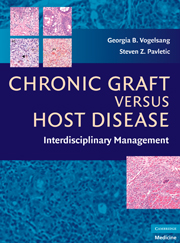Book contents
- Frontmatter
- Contents
- List of Contributors
- Preface
- PART I GENERAL PRINCIPLES
- PART II CLINICAL MANAGEMENT
- 9 Diagnosis and Staging
- 10 Chronic Graft versus Host Disease Pharmacology
- 11 Prevention of Chronic Graft versus Host Disease
- 12 Front Line Treatment of Chronic Graft versus Host Disease
- 13 Salvage Therapy in Chronic Graft versus Host Disease
- 14 Evaluating Therapeutic Response in Chronic Graft versus Host Disease
- 15 General Principles of Ancillary and Supportive Care
- PART III ORGAN SITE OR SYSTEM-SPECIFIC MANIFESTATIONS
- PART IV SPECIAL CONSIDERATIONS IN CHRONIC GVHD
- Index
- Plate section
11 - Prevention of Chronic Graft versus Host Disease
from PART II - CLINICAL MANAGEMENT
Published online by Cambridge University Press: 26 August 2009
- Frontmatter
- Contents
- List of Contributors
- Preface
- PART I GENERAL PRINCIPLES
- PART II CLINICAL MANAGEMENT
- 9 Diagnosis and Staging
- 10 Chronic Graft versus Host Disease Pharmacology
- 11 Prevention of Chronic Graft versus Host Disease
- 12 Front Line Treatment of Chronic Graft versus Host Disease
- 13 Salvage Therapy in Chronic Graft versus Host Disease
- 14 Evaluating Therapeutic Response in Chronic Graft versus Host Disease
- 15 General Principles of Ancillary and Supportive Care
- PART III ORGAN SITE OR SYSTEM-SPECIFIC MANIFESTATIONS
- PART IV SPECIAL CONSIDERATIONS IN CHRONIC GVHD
- Index
- Plate section
Summary
INTRODUCTION
Chronic graft versus host disease (GVHD) is the major complication in long-term survivors of an allogeneic hematopoietic stem cell transplant (HSCT): its detrimental effect on quality of life, especially when extensive or severe, together with its protective role on leukemia relapse are well documented. This chapter will outline programs designed to prevent GVHD, including the use of agents capable of modulating T-cell function. Recent developments in our understanding of the sclerodermatous form of chronic GVHD (cGVHD) and its clinical implications will also be discussed.
TIMING OF CHRONIC GVHD
This division on day 100 between acute and cGVHD is currently considered artificial. With the advent of nonmyeloablative hematopoietic cell transplantation (HCT) regimens and the use of unrelated donor stem cells, there is a need to drop this arbitrary time point from the definition of these disease entities. Current studies are more likely to utilize the clinical manifestations of these diseases rather than the arbitrary cutoff of a particular date post transplantation. This has been the conclusion of an international group of experts.
A continuum of clinical findings (i.e., “overlap syndrome”) may be observed in patients with acute and cGVHD, as both disorders commonly affect similar organs, principally the skin, liver, and gastrointestinal tract. However, the target organs affected by and the clinical and histologic features associated with cGVHD may differ from those observed with acute disease. As an example, autoimmune phenomena, such as autoantibody formation, are more common with chronic disease.
- Type
- Chapter
- Information
- Chronic Graft Versus Host DiseaseInterdisciplinary Management, pp. 117 - 123Publisher: Cambridge University PressPrint publication year: 2009
- 1
- Cited by

